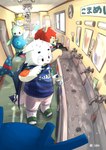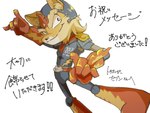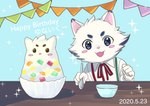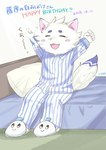
Meta: japanese text
post #1690949 post #1652901 post #1642572 post #4229920
These images or animations show text written in Japanese.
Japanese text often consists of a mix of logographic characters called "kanji" and syllabic characters called "kana."
Logogram are "letters" that represent a word or a phrase. They tend to be complex in appearance.
Kana represent a syllable: Ka, Ho, Mu, for example.
Kana can be used to write full sentences without the use of Kanji. Most Japanese text will be a mix of both. However, if you see a sentence made entirely of Kanji, it is likely that you are actually looking at Chinese text instead.
To add additional complication, Japanese "kana" is actually 2 different "alphabets," which are used for different purposes. Hiragana is the most commonly used, while Katakana is used like we might use italicized text: to indicate foreign words, sound effects, emphasis, and so forth.
If you can read Katakana, you can read most of the sound effects found on Japanese pictures. Though they may still be confusing, as Japan uses a lot of onomatopoeias.
Guide to reading Hiragana and Katakana
Simply put, each sound is made of a consonant and a vowel, unless the sound is JUST a vowel sound.
So, for reading the tables below, take the consonant on the left and combine it with the vowel on the top.
Hiragana
Hiragana
| a | i | u | e | o | |
|---|---|---|---|---|---|
| あ | い | う | え | お | |
| k | か | き | く | け | こ |
| s | さ | し | す | せ | そ |
| t | た | ち | つ | て | と |
| n | な | に | ぬ | ね | の |
| h | は | ひ | ふ | へ | ほ |
| m | ま | み | む | め | も |
| y | や | ゆ | よ | ||
| r | ら | り | る | れ | ろ |
| w | わ | を |
Katakana
Katakana
| a | i | u | e | o | |
|---|---|---|---|---|---|
| ア | イ | ウ | エ | オ | |
| k | カ | キ | ク | ケ | コ |
| s | サ | シ | ス | セ | ソ |
| t | タ | チ | ツ | テ | ト |
| n | ナ | ニ | ヌ | ネ | ノ |
| h | ハ | ヒ | フ | ヘ | ホ |
| m | マ | ミ | ム | メ | モ |
| y | ヤ | ユ | ヨ | ||
| r | ラ | リ | ル | レ | ロ |
| w | ワ | ヲ |
Exceptions:
There are a few exceptions, due to the limitations of the Latin alphabet:
- si is "shi"
ti is "chi"
tu is "tsu"
ん or ン is "n" or sometimes "ng"
Diacritic marks and other quirks
Dakuten and Handakuten
Additionally, many of the characters can be modified with a single symbol that changes the initial consonant.
The first is called Dakuten, and can be seen here: ゛It is a pair of small lines in the upper right corner of the character.
Dakuten (sometimes called ten-ten) means the following changes:
- The "ka" line becomes the "ga" line.
"Sa" becomes "Za". (however, "shi" becomes "Ji")
"Ta" becomes "Da". (however, "chi" also becomes "ji," and "tsu" becomes "zu".)
"Ha" becomes "Ba".
The second is called Handakuten, and can be seen here: ゜It is a small circle in the upper right corner.
- "Ha" becomes "Pa"
Yōon
Sometimes you may see a small letter in the lower right of a larger one. These are usually the letters for Ya, Yu and Yo. These modify the sound of the letter that came before. This letter will always end with an -i sound.
So.. ki, shi, ni, mi, etc.
- A Ki followed by a Ya, will make the sound "kya."
A Ni followed by a Yo, will make the sound "Nyo."
Sokoun
A small "tsu" symbol means "double the consonant that comes next"
For example:
- Po - (small tsu) - Ki would be Pokki
Chōonpu
A long straight line means to repeat the preceding vowel sound.
ハー, for example, would be "haa"
Conclusion
Obviously, this is a very expansive topic for this wiki and if you are interested in learning more, there is a wide variety of resources available.
Examples for study!
| Kanji | Kana | Romanji | translation |
|---|---|---|---|
| ポケットモンスター | poketto monstaa | pokemon | |
| ゼクロム | zekuromu | zekrom | |
| 明日 | あした | ashita | tomorrow |
| 獣 | ケモノ | kemono | animal |
| ドラゴン | doragon | dragon | |
| 竜 | りゅう | ryu | dragon, especially eastern. |
| 犬 | いぬ | inu | dog |
| 猫 | ねこ | neko | cat |
See Also:
The following tags are aliased to this tag: hiragana, japanese_language, japanese_writing (learn more).
This tag implicates text (learn more).
Posts (view all)



